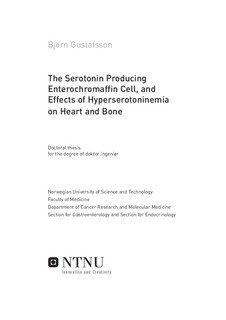| dc.contributor.author | Gustafsson, Björn I | nb_NO |
| dc.date.accessioned | 2014-12-19T14:16:46Z | |
| dc.date.available | 2014-12-19T14:16:46Z | |
| dc.date.created | 2006-04-06 | nb_NO |
| dc.date.issued | 2005 | nb_NO |
| dc.identifier | 125898 | nb_NO |
| dc.identifier.isbn | 82-471-7312-3 | nb_NO |
| dc.identifier.uri | http://hdl.handle.net/11250/263149 | |
| dc.description.abstract | Neuroendocrine (NE) cells are found in a majority of the body organs. In the gastrointestinal (GI) tract, enterochromaffin cells (EC) constitute the largest NE cell population and they are distributed from the cardia to the anus. The EC cell population includes several different sub-populations, and morphological differences in shape, luminal endings and secretory granules suggest region-specific functions. The main secretory product of EC cells is serotonin and EC cells account for more than 90 % of all serotonin synthesized in the body. Serotonin is thought to be released from the EC cell by degranulation at the base of the cell as a response to luminal stimuli acting on the apical part of the cell. Serotonin functions as a key regulator of regional blood flow, motility and secretion in the gut. The embryological origin of EC cells is still under debate. Many researchers today believe that EC cells are derived from a local mucosal stem cell. In paper (I) we described a new method for visualizing morphologically intact mucosal EC cells. Some EC cells made contact with mucosal cells via axon-like, infranuclear cytoplasmatic extensions, while others had extensions that connected with underlying neurons. A third EC cell type had no or only short and blunt extensions. The serotonin released from these EC cells may reach targets such as neighboring cells or fenestrated capillaries through diffusion. EC cells were found to have striking morphological similarities with serotonergic neurons, thus indicating that they are derived from the neural crest. The finding of EC cells in mitosis, also makes the local mucosal stem cell theory less plausible.
Carcinoid tumors arising from the EC cell produce large amounts of serotonin and other hormonally active substances, giving rise to the carcinoid syndrome. The major features of the carcinoid syndrome are flushing, diarrhea, asthma and the carcinoid heart disease. Carcinoid heart disease occurs in more than 65 % of patients with the carcinoid syndrome and is characterized by fibrous thickening of cardiac valves, leading to heart failure. Whether serotonin is directly responsible for these cardiac abnormalities has so far been unknown. In order to address this issue we injected rats with high doses of serotonin once daily for three months (II). For the first time we could show that serotonin administration leads to a carcinoid heart-like condition in rats, thus proving the relationship between serotonin and heart valve disease.
Serotonin is a well-known mitogen with proliferative effects on different cells of mesenchymal origin as well as macrophages via specific serotonin receptors. Two key cell types involved in bone metabolism are the mesenchymally derived bone forming osteoblasts and the bone-resorbing osteoclasts derived from the monocyte/macrophage lineage. It was recently shown that osteoblasts and osteoclasts have functional serotonin receptors. In paper (III) we performed in vitro experiments demonstrating that serotonin induces proliferation of human bone marrow stem cells, human osteoblasts and murine preosteoblasts. Serotonin also increased osteoclast differentiation and activity. This effect, however, seemed to be opposed by the finding that serotonin induced an increase in the OPG/RANKL ratio in osteoblast cell culture medium, indicating an inhibitory effect on bone resorption. A regulatory function for serotonin in bone became even more likely when we found that osteoblasts and osteoclasts expressed tryptophan hydroxylase 1 (Tph 1), the rate-limiting enzyme in serotonin synthesis, indicating that they are able to produce serotonin. We also investigated the effects of the selective serotonin reuptake inhibitor (SSRI) fluoxetine on bone metabolism in vitro. Fluoxetine inhibited osteoblast proliferation and reduced the OPG/RANKL ratio, indicating an overall negative effect on bone metabolism. These results may be of clinical importance as fluoxetine is the most used antidepressant drug worldwide. To evaluate possible effects of serotonin on bone formation in vivo, a long-term study with daily, low dose serotonin injections was performed in growing rats (IV). After three months, a significant increase in bone mineral density (BMD) developed. Micro-computed tomography (μCT) scans were performed to study bone architecture. In the serotonin group, the femoral cortex was thicker, whereas the trabecular bone volume was lower compared to controls, indicating a decrease in bone resorption or/and increased apposition of endosteal bone. These data were in accordance with the fact that the serotonin dosed animals had stiffer bones in mechanical tests. The in vivo findings may be explained by the serotonin-induced increase in proliferation of osteoblastic cells and elevated OPG/RANKL ratio induced by serotonin in vitro. | nb_NO |
| dc.language | eng | nb_NO |
| dc.publisher | Det medisinske fakultet | nb_NO |
| dc.relation.ispartofseries | Doktoravhandlinger ved NTNU, 1503-8181; 2005:208 | nb_NO |
| dc.relation.haspart | Gustafsson, BI; Tømmerås, K; Nordrum, I; Loennechen, JP; Brunsvik, A; Solligard, E; Fossmark, R; Bakke, I; Syversen, U; Waldum, H. Long-Term Serotonin Administration Induces Heart Valve Disease in Rats. Circulation. 111(12): 1517-22, 2005. | nb_NO |
| dc.relation.haspart | Gustafsson, BI; Westbroek, I; Waarsing, JH; Waldum, HL; Solligard, E; Brunsvik, A; Dimmen, S; Leeuwen, JP; Weinans, H; Syversen, U. Long-term serotonin administration leads to higher bone mineral density, affects bone architecture, and leads to higher femoral bone stiffness in rats. Journal of Cellular Biochemistry. 97(6): 1283-1291, 2005. | nb_NO |
| dc.title | The Serotonin Producing Enterochromaffin Cell, and Effects of Hyperserotoninemia on Heart and Bone | nb_NO |
| dc.type | Doctoral thesis | nb_NO |
| dc.contributor.department | Norges teknisk-naturvitenskapelige universitet, Det medisinske fakultet | nb_NO |
| dc.description.degree | dr.ing. | nb_NO |
| dc.description.degree | dr.ing. | en_GB |
